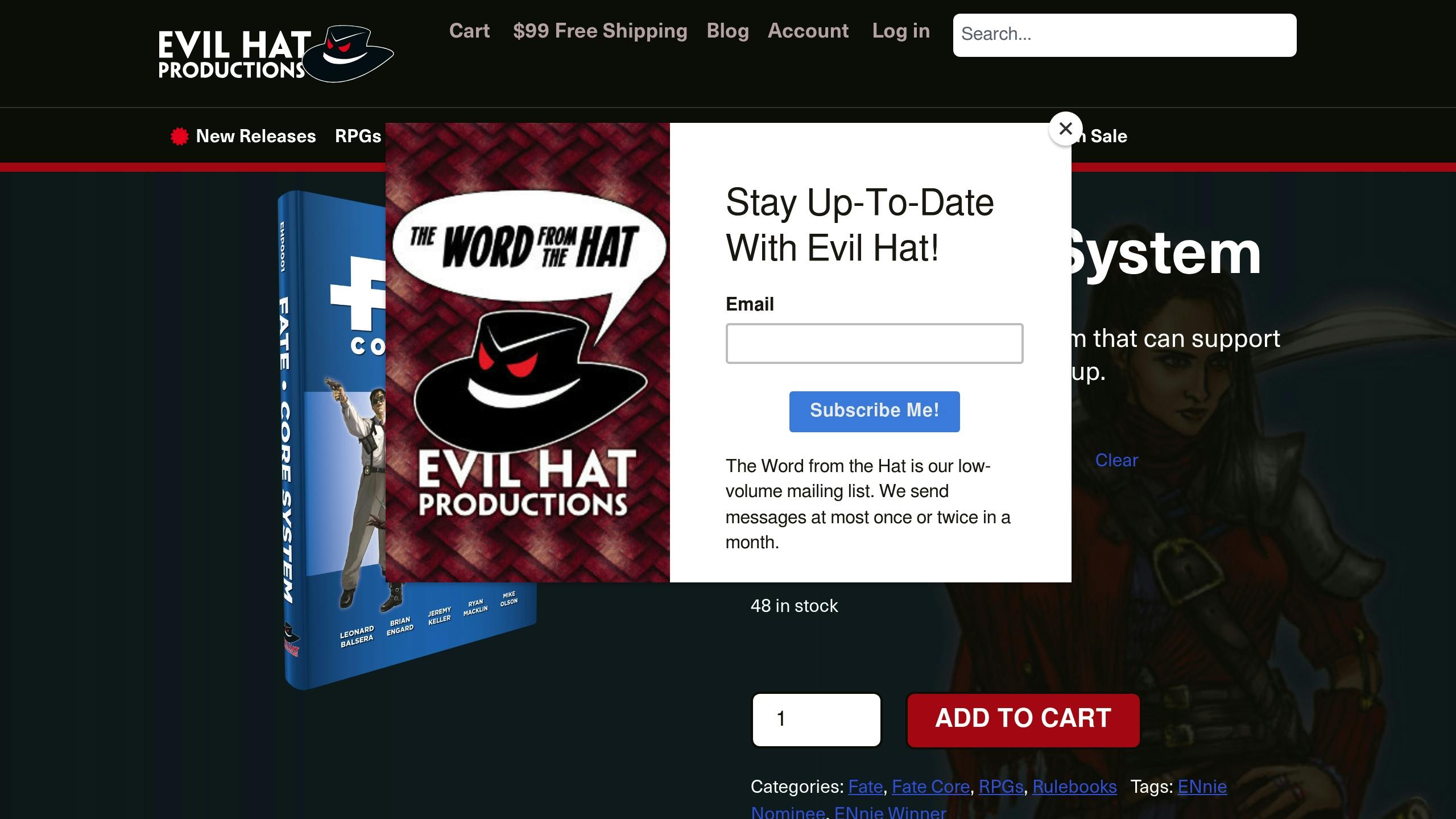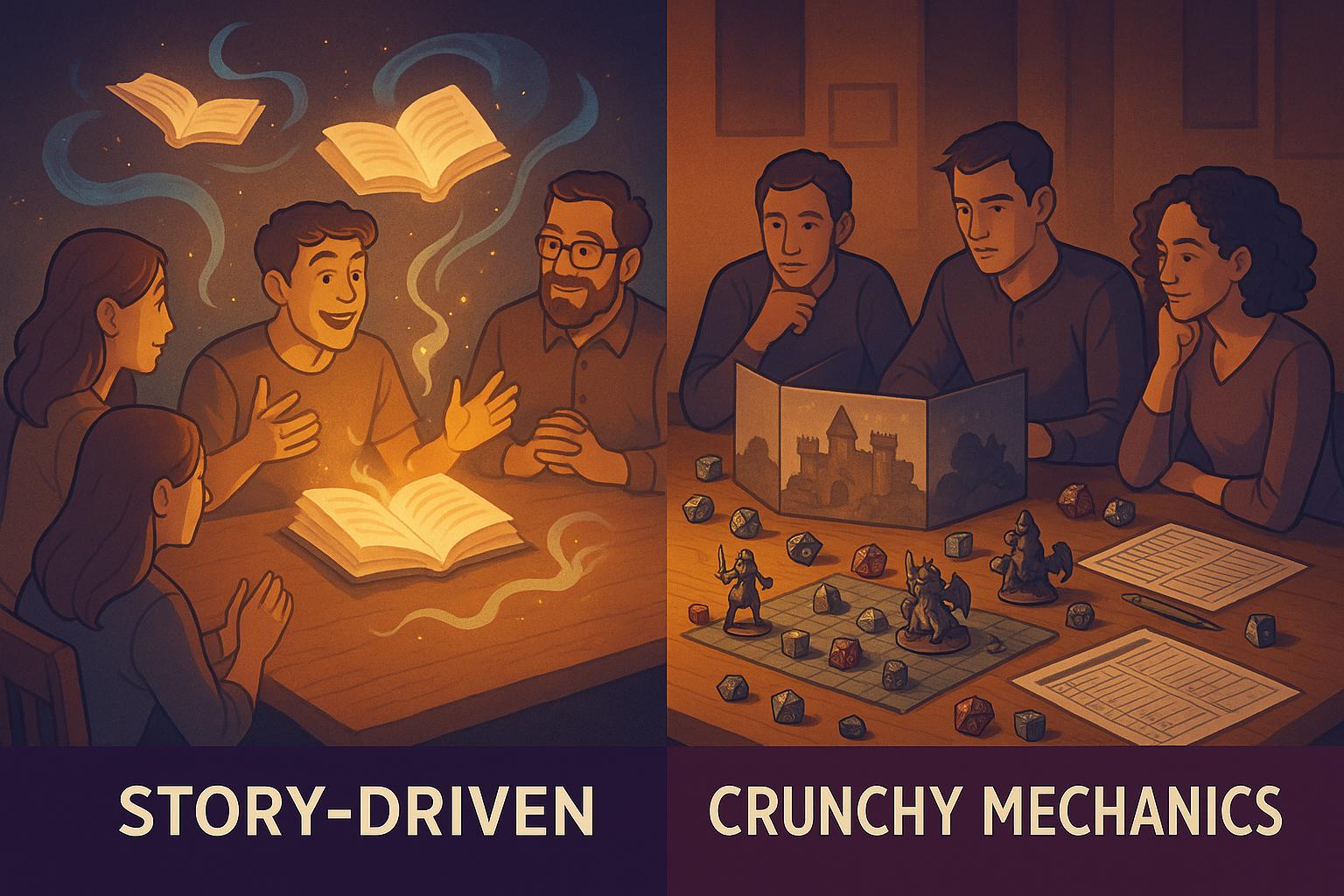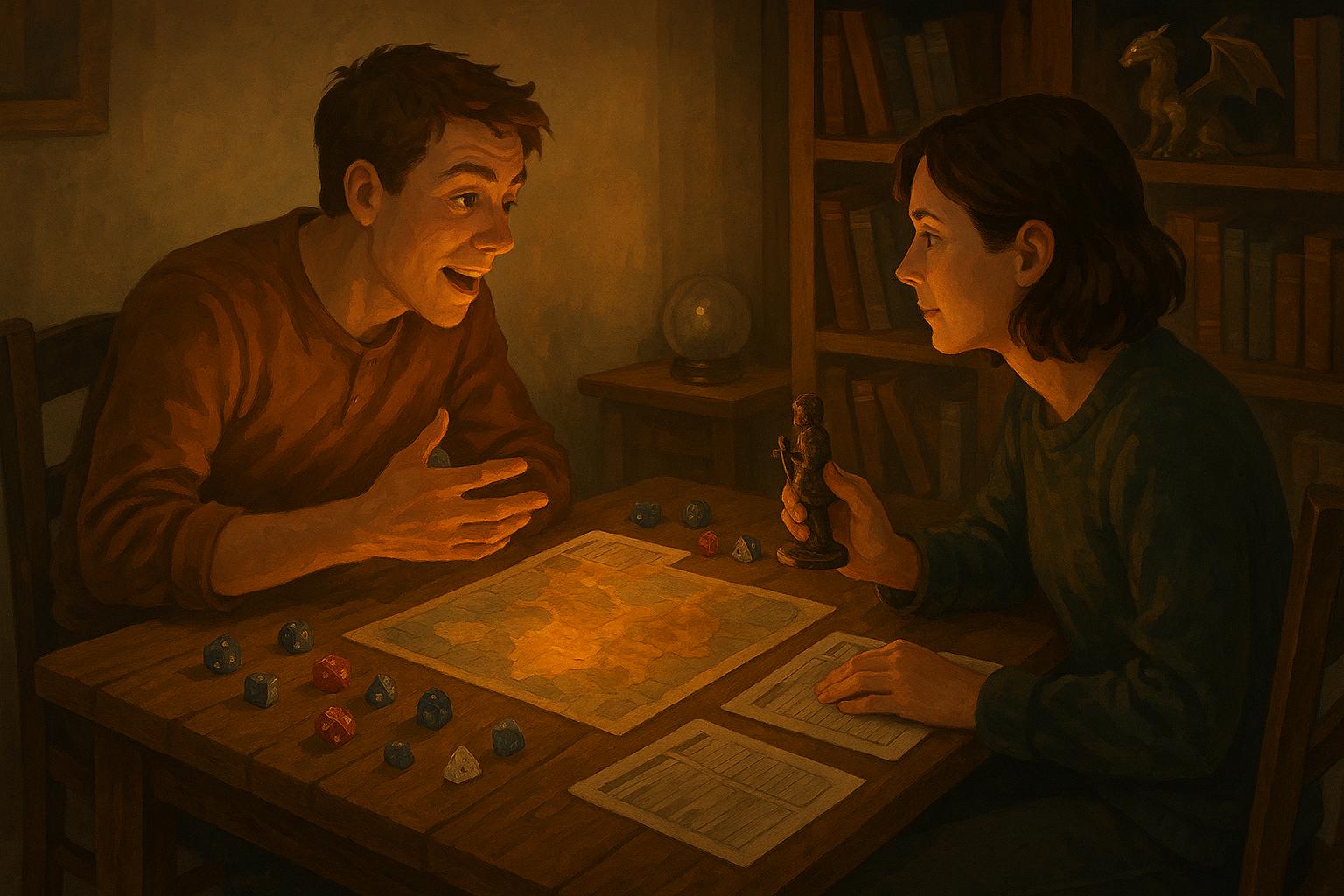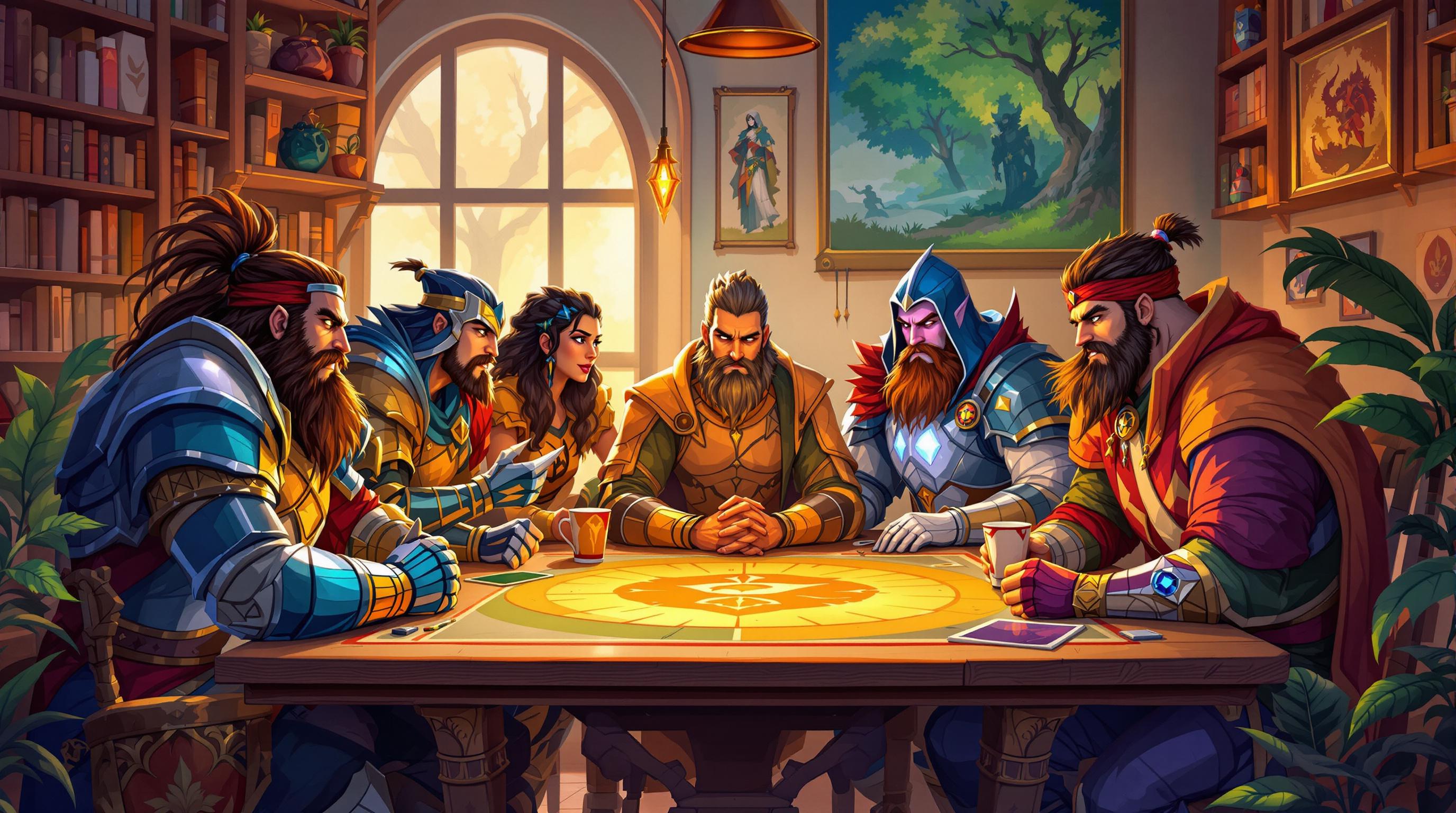Shared narrative control in tabletop RPGs is a collaborative storytelling approach where players and the Game Master (GM) share responsibility for shaping the story. Unlike traditional RPGs, where the GM controls the narrative, this method allows players to influence world-building, character development, plot twists, and NPC creation. The result? A more engaging, dynamic, and player-driven experience.
Key Points:
- Player Involvement: Players actively contribute to the story, creating deeper connections and more personal plots.
- Dynamic Storytelling: Stories evolve organically, with surprising twists and richer character relationships.
- Less GM Stress: Sharing narrative duties reduces the GM's workload and fosters creativity.
- Game Systems: Titles like Fate Core, Blades in the Dark, and Fiasco support shared storytelling mechanics.
Quick Comparison: Traditional GM-Only vs. Shared Narrative Control
| Aspect | Traditional GM-Only | Shared Narrative Control |
|---|---|---|
| Story Direction | GM plans all plot elements | Players and GM collaborate |
| World Building | GM defines the setting | Players add details dynamically |
| NPC Creation | GM creates and controls NPCs | Players suggest or create NPCs |
| Plot Twists | GM decides major developments | Group introduces twists together |
To try it out, start small: let players describe scenes, add local details, or suggest NPC traits. Choose systems like Fate Core or Blades in the Dark for built-in tools that support shared storytelling.
Fate Core - Collaborative Storytelling At Its Best

Main Advantages
Shared narrative control brings benefits to players, story progression, and GMs alike.
Player Involvement
When players take an active role in shaping the game world, their engagement deepens. They're not just following the GM's lead - they're co-creators of the story. This fosters a stronger emotional connection and encourages players to take creative risks.
By contributing to world-building and plot development, players often craft more detailed character backstories. Knowing their ideas have a direct impact on the game makes their participation more meaningful and helps the narrative grow in unexpected ways.
Story Development
Collaborative storytelling leads to richer, more dynamic plots. Player contributions can create surprising twists, such as tying a character's history to key locations or events, making the story feel more personal and immersive.
| Story Element | Traditional Approach | Shared Narrative Impact |
|---|---|---|
| Plot Twists | Planned and revealed by GM | Arise naturally from player input |
| Character Relationships | Pre-written by GM | Develop organically through interaction |
| World Details | Fixed and pre-determined | Shaped dynamically by players |
| Side Quests | GM-created missions | Inspired by player character backstories |
GM Stress Reduction
Sharing narrative control also lightens the GM's workload. Players contribute to world-building, plot ideas, and NPC creation, reducing the pressure on the GM to handle every detail.
This collaborative approach allows GMs to:
- Focus more on guiding gameplay rather than micromanaging the story.
- Adjust quickly to unexpected player choices.
- Split preparation tasks with the group.
- Stay energized and inspired by incorporating player-driven ideas.
Using Shared Narrative Control
Here's how to bring shared narrative control into your gameplay while keeping things organized and engaging.
Methods for Sharing Story Control
To make shared narrative control work, you need clear rules and a structured approach. These are some methods that gaming groups have successfully used:
Scene Framing: Let players set up specific scenes. For instance, when the group arrives in a new town, players can describe notable landmarks or NPCs they encounter. This boosts their engagement while the GM still manages the overarching plot.
Flashback Mechanics: Allow players to introduce past events during the game. This can help:
- Expand character backstories
- Build connections with NPCs
- Explain how characters obtained certain skills or items
Environmental Control: Players can add details to the surroundings, creating a more interactive and evolving world, while the GM keeps the main narrative intact.
Keeping Stories Focused
Balancing multiple creative voices while maintaining a coherent story can be tricky. Use these strategies to stay on track:
| Control Element | Player Input | GM Oversight |
|---|---|---|
| Main Plot | Minor contributions | Core direction |
| Scene Details | Creative freedom | Veto power |
| NPC Creation | Supporting characters | Key story figures |
| World Building | Local details | Major settings |
Set Clear Boundaries: Define what parts of the story players can shape and what stays under GM control. This avoids misunderstandings and keeps the story consistent.
Use "Yes, and...": Build on players' ideas instead of dismissing them. This approach keeps the story collaborative while letting you guide it effectively.
Game Systems and Resources
Some RPG systems already include mechanics for shared narrative control. Here are a few examples:
- Fate Core: The "Compel" system allows players to suggest plot twists in exchange for Fate Points, creating a balance between player input and story progression.
- Blades in the Dark: Features "Flashback Actions", letting players retroactively set up actions or events, adding depth without interrupting the game flow.
For new groups, these tools can help:
- Story Dice: Dice with symbols that players interpret to add narrative elements.
- Scene Cards: Pre-made prompts players can draw to inspire story contributions.
- Collaborative World-Building Sheets: Templates to organize and track player-created setting details.
These techniques and tools can make shared narrative control both fun and manageable for everyone involved.
sbb-itb-b8b00a5
Common Problems and Solutions
Collaborative storytelling can be incredibly rewarding, but it comes with its own set of challenges. Let’s look at some common issues and practical ways to address them.
Major Issues to Watch For
When multiple players share control of the narrative, a few problems can arise:
- Spotlight Hogging: Some players might dominate the story. To prevent this, try using a story token system that limits how much each player can contribute during a session.
- Conflicting Ideas: Players may suggest contradictory story elements. A voting system can help resolve these conflicts quickly and fairly.
Here’s a quick breakdown of common issues and their solutions:
| Issue | Solution | Implementation |
|---|---|---|
| Plot Conflicts | Establish a voting system | Group votes on conflicting ideas |
| Setting Details | Use a consistency document | Keep track of world-building facts |
| Character Motivations | Create relationship maps | Visualize character connections |
- Power Gaming: Some players might manipulate the story to gain unfair advantages. To avoid this, establish clear rules about how narrative contributions can impact game mechanics.
Now that we’ve covered the problems, let’s talk about keeping the story on track.
Maintaining Story Structure
A collaborative story can quickly lose focus without a clear framework. Use these strategies to keep things organized:
- Story Arc Framework: Outline key plot points in advance to guide the overall narrative.
- Narrative Zones:
- Core Plot: The Game Master (GM) retains control over the main storyline.
- Personal Arcs: Players take charge of their individual character development.
- World Details & NPC Interactions: Everyone contributes to world-building and interactions with non-player characters (NPCs).
This division helps balance creative input while keeping the story cohesive.
Setting Appropriate Limits
Clear boundaries are essential to ensure fairness and consistency. Here are a few rules to set:
- Gradually introduce player contributions to avoid overwhelming the narrative.
- Establish these ground rules:
- No contradicting major plot points.
- No controlling other players’ characters.
- No elements that break the genre.
- No retroactive changes to the story.
RPG Systems with Shared Storytelling
Games Using This Approach
Some tabletop RPGs today put shared storytelling front and center, giving players more control over the narrative:
- Fiasco: This GM-free game has players work together to create and play out dramatic scenes. Its structured setup phase ensures everyone contributes to building relationships and shaping the story.
- Blades in the Dark: Known for its flashback mechanic, this game allows players to describe their prior preparations for heists, blending past and present events seamlessly while keeping the story cohesive.
- Fate Core: With its Aspect and Compel systems, players can introduce new story twists and complications, adding depth to the narrative.
Choosing a System
When picking an RPG system that involves shared storytelling, consider these factors:
| Factor | What to Look For | Why It Matters |
|---|---|---|
| System Structure | How much the mechanics support shared narration | Helps guide the storytelling process |
| Experience Needed | Familiarity with collaborative storytelling | Impacts the ease of learning and playing |
| Story Flexibility | How well it suits different story genres | Ensures it aligns with your group’s style |
If your group is new to this style of gaming, lighter systems are a good place to start. For example, Powered by the Apocalypse offers a nice balance, combining clear rules with room for creativity.
For more insights, check out the TTRPG Games Directory for detailed comparisons.
TTRPG Games Directory

The TTRPG Games Directory (ttrpg-games.com) is a great resource for finding systems that focus on shared storytelling. It offers:
- Clear explanations of how much players contribute to the story
- Insights into both game mechanics and narrative tools
- Detailed breakdowns of storytelling features
When browsing, look for games tagged with "collaborative storytelling" or "shared narrative" to find options that best match your group’s preferences.
Summary
Main Points
Shared narrative control offers a way for players to shape the story, leading to more engaging plots, less pressure on the Game Master (GM), and stronger connections to characters. Games like Fiasco and Blades in the Dark highlight how these mechanics create collaborative storytelling while keeping the narrative on track.
Here’s how shared narrative control can improve your gameplay:
Key Advantages:
- Players feel more involved by contributing directly to the story
- Plots become more dynamic and less predictable
- Eases the GM's workload by sharing storytelling duties
- Builds stronger connections between players and their characters
Next Steps
To bring shared narrative control into your game, try these approaches:
| Step | Action | Expected Outcome |
|---|---|---|
| Start Small | Allow limited narrative control in specific scenes | Helps players ease into their role as storytellers |
| Set Guidelines | Define clear boundaries for player contributions | Keeps the story consistent and aligned with the genre |
| Choose Tools | Pick mechanics that fit your group’s preferences | Adds structure to the collaborative storytelling |
You can begin with these simple actions:
- Let players describe the results of their successful actions
- Encourage them to add small details to scene settings
- Use group voting for big plot decisions
For newer groups, choose systems with clear rules that balance player input and structured storytelling. Gradually adjust how much narrative control players have as your group gains experience.


